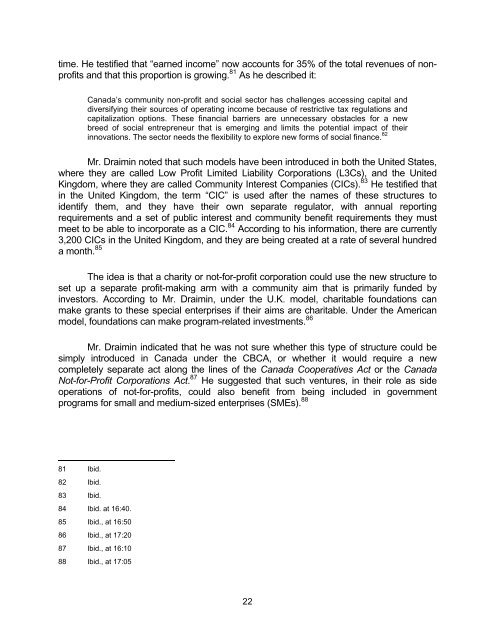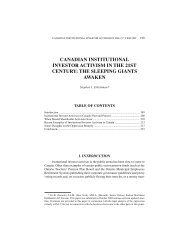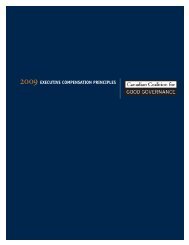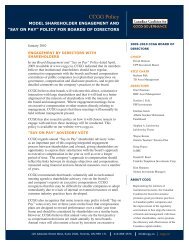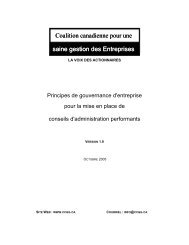statutory review of the Canada Business Corporations Act
statutory review of the Canada Business Corporations Act
statutory review of the Canada Business Corporations Act
Create successful ePaper yourself
Turn your PDF publications into a flip-book with our unique Google optimized e-Paper software.
time. He testified that “earned income” now accounts for 35% <strong>of</strong> <strong>the</strong> total revenues <strong>of</strong> nonpr<strong>of</strong>its<br />
and that this proportion is growing. 81 As he described it:<br />
<strong>Canada</strong>’s community non-pr<strong>of</strong>it and social sector has challenges accessing capital and<br />
diversifying <strong>the</strong>ir sources <strong>of</strong> operating income because <strong>of</strong> restrictive tax regulations and<br />
capitalization options. These financial barriers are unnecessary obstacles for a new<br />
breed <strong>of</strong> social entrepreneur that is emerging and limits <strong>the</strong> potential impact <strong>of</strong> <strong>the</strong>ir<br />
innovations. The sector needs <strong>the</strong> flexibility to explore new forms <strong>of</strong> social finance. 82<br />
Mr. Draimin noted that such models have been introduced in both <strong>the</strong> United States,<br />
where <strong>the</strong>y are called Low Pr<strong>of</strong>it Limited Liability <strong>Corporations</strong> (L3Cs), and <strong>the</strong> United<br />
Kingdom, where <strong>the</strong>y are called Community Interest Companies (CICs). 83 He testified that<br />
in <strong>the</strong> United Kingdom, <strong>the</strong> term “CIC” is used after <strong>the</strong> names <strong>of</strong> <strong>the</strong>se structures to<br />
identify <strong>the</strong>m, and <strong>the</strong>y have <strong>the</strong>ir own separate regulator, with annual reporting<br />
requirements and a set <strong>of</strong> public interest and community benefit requirements <strong>the</strong>y must<br />
meet to be able to incorporate as a CIC. 84 According to his information, <strong>the</strong>re are currently<br />
3,200 CICs in <strong>the</strong> United Kingdom, and <strong>the</strong>y are being created at a rate <strong>of</strong> several hundred<br />
a month. 85<br />
The idea is that a charity or not-for-pr<strong>of</strong>it corporation could use <strong>the</strong> new structure to<br />
set up a separate pr<strong>of</strong>it-making arm with a community aim that is primarily funded by<br />
investors. According to Mr. Draimin, under <strong>the</strong> U.K. model, charitable foundations can<br />
make grants to <strong>the</strong>se special enterprises if <strong>the</strong>ir aims are charitable. Under <strong>the</strong> American<br />
model, foundations can make program-related investments. 86<br />
Mr. Draimin indicated that he was not sure whe<strong>the</strong>r this type <strong>of</strong> structure could be<br />
simply introduced in <strong>Canada</strong> under <strong>the</strong> CBCA, or whe<strong>the</strong>r it would require a new<br />
completely separate act along <strong>the</strong> lines <strong>of</strong> <strong>the</strong> <strong>Canada</strong> Cooperatives <strong>Act</strong> or <strong>the</strong> <strong>Canada</strong><br />
Not-for-Pr<strong>of</strong>it <strong>Corporations</strong> <strong>Act</strong>. 87 He suggested that such ventures, in <strong>the</strong>ir role as side<br />
operations <strong>of</strong> not-for-pr<strong>of</strong>its, could also benefit from being included in government<br />
programs for small and medium-sized enterprises (SMEs). 88<br />
81 Ibid.<br />
82 Ibid.<br />
83 Ibid.<br />
84 Ibid. at 16:40.<br />
85 Ibid., at 16:50<br />
86 Ibid., at 17:20<br />
87 Ibid., at 16:10<br />
88 Ibid., at 17:05<br />
22


